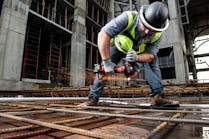Choate Construction Company and Jacobs Technology, a subsidiary of Jacobs Engineering Group, are approaching the finish line for completion of Windshear, Inc.'s $40-million, 180-mph rolling road wind tunnel facility. Construction on the 40,000-square-foot facility began in March this year on a five-acre site near Concord Regional Airport. Choate Construction's scope of work has included the site work, construction of the facility's control/office building and the test section of the wind tunnel. Following a month of site preparation work, Buchanan Concrete began pouring the first foundation in April — a 990-cubic-yard foundation slab in the basement level of the test section that must support the 78-ton rolling road. "The massive foundation slab that supports the rolling road and the test section is on center point of the entire project, and is typically 3.5 feet thick and increases to 5.5 feet thick," says Matt Hartig, project manager with Choate Construction. "The cast-in-place concrete foundation slab is heavily reinforced with 150 tons of #8 and #9 bars that are in two mats with bars 6 inches on center each way. It took two weeks to tie the reinforcing steel and set the form work for the first 4,500-square-foot pour, and this was just for the test section." From here Choate began going vertical with the cast-in-place walls. Critical to the test section — and to the entire project — is the elevated floor level that features a 42-foot diameter opening with 31 embed plates. These had to be set with precision in a 27-inch-thick slab edge that supports the 56,000-pound turntable that will work in conjunction with the rolling road. Establishing and maintaining the center line for this opening, which is also the center point for the entire project, was crucial to ensure that the turntable would align properly with the wind tunnel. Choate brought in Stewart Engineering, as well as its in-house field engineers, on several occasions to survey the site and verify the work as it progressed. Complicating the process even further was that Jacobs Technology has been responsible for the construction of the wind tunnel that will tie into the test section, so extensive coordination was required. "The biggest thing was to maintain that same point from the first time is was put down through the end of the job. It was constantly double checking, bringing out the surveyors to make sure Jacobs' work matched with ours and vice versa," says Scott Willett, Choate project superintendent. Once the turntable is brought in and installed on the embeds, there will be a final survey to verify that everything is aligned correctly. The turntable will then be able to turn 16 degrees to accommodate vehicles. Choate completed construction on the test section in July and then moved onto the control and office building, which is a steel structure. Meanwhile Jacobs Technology has been at work on the wind tunnel structure. Essentially a large duct with a fan, the tolerances for the tunnel are extremely tight — one-eighth of an inch. During testing a 22-foot-diameter main fan circulates 2.85 million cubic feet of air per minute through the wind tunnel in a clockwise direction. The air moves through two turns and is forced into a contraction or nozzle before moving into the test section and impacting the test vehicle. It is then collected at the opposite side of the work section and routed back to the fan, completing the circuit. The air flow has to be extremely uniform during the simulation process, according to Bruce Banfield, senior project manager with Jacobs Technology. "We have to get the turbulence levels down. (The test section) is simulating relatively still air when it's actually passing the car at 180 mph. It's a continuous curve that has to be constructed to very tight tolerances. We're also doing this out of concrete, which is more of a challenge to control, and it's a large structure as well in which to do this." The turntable with its rectangular opening sits in the middle of the test center. The surface of the rolling road, which Banfield describes as a very expensive, elaborate belt sander turned upside down, rises up from the basement level and fits into this rectangular opening. The surface of the road is a stainless steel belt that sits flush with the turntable. To get tested, a vehicle is brought down a secure corridor from one of four bays to the test center. It's rolled right onto the turntable and the rolling road's surface and fixed into place with tethers that are attached to several posts on either side. The car then "travels" at 180 mph while the wind flows through the tunnel, also at 180 mph. The "through-the-belt" measurement system then measures the aerodynamic down force under each tire through the belt. When completed in 2008, the Windshear Wind Tunnel will be the only one of its type in North America, and only the third rolling road of this size in the world. Windshear, Inc. will ultimately operate the one-of-a-kind facility 24 hours a day, 7 days a week, with a staff of 25. The tunnel will be available for all motorsports teams and auto manufacturers to rent, complementing other nearby research-and-development facilities.
|




